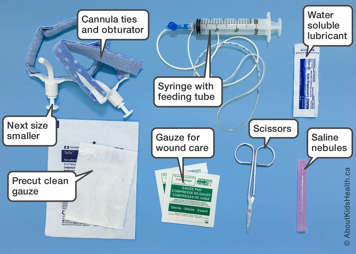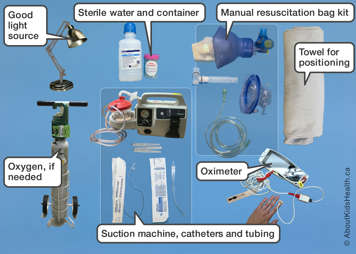Many children with tracheostomies use the tracheostomy tube as their main airway. If the tube becomes obstructed (blocked) or dislodged, it is important to know how to respond safely and quickly.
How can a tracheostomy tube become blocked?
Blockages can happen when:
- secretions from your child’s lungs become thick and form a mucus plug
- a foreign body gets stuck in the tube
- the tube itself is kinked or in the wrong position.
A blocked tube is an emergency and can lead to respiratory distress (severe breathing difficulties) if it is not cleared quickly.
How can I tell if there is a problem with my child’s tracheostomy tube?
At first, you might notice the following early signs of respiratory distress in your child:
- coughing
- anxiety or restlessness that cannot be calmed with usual comforting
- new noises from the tube or around it (for example whistling or voice sounds)
- visible secretions (mucus) in the tube
- difficulty passing the suction catheter down the tube
- increased heart rate and breathing
- lower oxygen saturation.
If the issue is not resolved, you will notice the following late signs of respiratory distress:
- obvious distress in your child
- retractions (pulling in of neck or chest skin with each breath)
- pale or blue skin around the eyes, mouth, fingers and toenails
- “rattling” on the child’s chest or back
- no breathing.
What should I do if there is a problem with my child’s tracheostomy tube?
There are three main steps to follow. Please do them in order.
1. Do a quick check
- Check if your child is awake and responds to your voice or your touch.
- Look: Is the chest rising and falling?
- Listen: Can you hear breathing sounds from your child’s tracheostomy tube, nose or mouth?
- Feel: Can you feel air moving from the tracheostomy tube, nose or mouth?
2. Try to suction the tracheostomy tube
- Extend your child’s neck to open the airway.
- Suction the tracheostomy tube to the depth you were shown during training. If you cannot insert the suction catheter into the tracheostomy tube, change the inner cannula if there is one. If there is no inner cannula, change the tracheostomy tube.
- After suctioning, if the tube is still blocked, change the tracheostomy tube. If you cannot put the tracheostomy tube back in, try placing the half size smaller tracheostomy tube.
3. Call 911
- Call 911 if your child still shows signs of respiratory distress after suctioning and changing the tracheostomy tube.
- If you are unable to insert the new tracheostomy tube or the half size smaller tracheostomy tube, ask someone to call 911 while you block the stoma with your finger and start mouth-to-mouth resuscitation.
How can I prepare for an emergency if my child and I are away from home?
When leaving home with a child with a tracheostomy, even for a short time, make sure that you have all necessary equipment with you. You can pack all the supplies in a medical travel bag.
The exact number of supplies you will need will depend on how long you plan to be away from home. In general, keep your medical travel bag stocked with enough supplies for an average day caring for your child. For full-day or multi-day trips, you will need to bring more supplies.
What to pack in your medical travel bag
Your medical travel bag will need to include:
- your child’s tracheostomy kit
- cleaning supplies
- additional equipment and supplies.
Tracheostomy kit
- Tracheostomy outer cannula with ties attached and obturator of the same size
- Tracheostomy tube one size smaller with ties attached and obturator (store in a small, well-labelled clear bag)
- Normal saline nebules (small, sealed tubes that are filled with saline)
- Water soluble lubricant
- Round-ended scissors
- Clean tracheostomy gauze (dressing)
- Manual suction setup: 20 mL syringe with feeding tube attached (in case the suction machine malfunctions)

Cleaning supplies
- Gauze pads
- Saline soaked cotton swabs (single use)
- Saline nebules
- Wet facecloth
- Dry facecloth

Additional equipment and supplies
- Wound care supplies, if needed.
- Suction machine, suction catheters/adjuncts and tubing
- Sterile water and container
- Good light source
- Manual resuscitation bag with tracheostomy adaptor and the appropriate sized mask
- Oximeter
- Oxygen, if needed

Important
You will need to replace some items in your medical travel kit after a single use. Before you leave your home, always check that the travel bag contains all the supplies you need and that all machines are working.